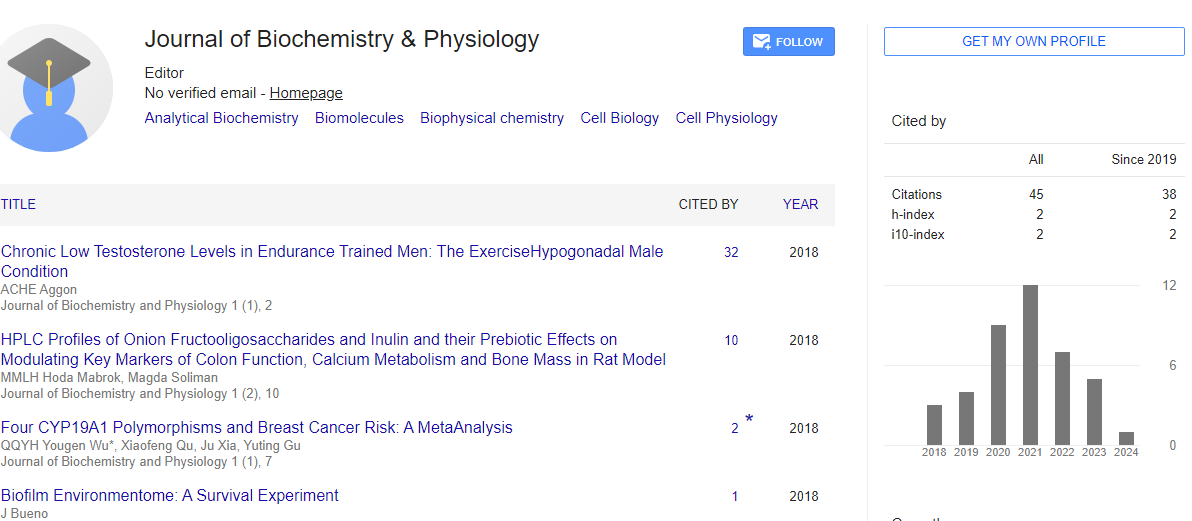Perspective, J Biochem Physiol Vol: 7 Issue: 3
Lipoteichoic Acid in Staphylococcus: A Biochemical Characterization and Its Role in Infection
Noah Casey*
1Department of Biochemistry and Molecular Biology, University of Melbourne, Melbourne, Australia
*Corresponding Author: Noah Casey,
Department of Biochemistry and Molecular
Biology, University of Melbourne, Melbourne, Australia
E-mail: casey.n@yahoo.com
Received date: 19 August, 2024, Manuscript No. JBPY-24- 149087;
Editor assigned date: 21 August, 2024, PreQC No. JBPY-24-149087 (PQ);
Reviewed date: 04 September, 2024, QC No. JBPY-24-149087;
Revised date: 12 September, 2024, Manuscript No. JBPY-24-149087 (R);
Published date: 19 September, 2024, DOI: 10.4172/jbpy.1000172.
Citation: Casey N (2024) Lipoteichoic Acid in Staphylococcus: A Biochemical Characterization and Its Role in Infection. J Biochem Physiol 7:3.
Description
Lipoteichoic Acid (LTA) is an important component of the cell wall of Gram-positive bacteria, including Staphylococcus species. It plays an essential role in bacterial physiology and pathogenesis, particularly in Staphylococcus aureus, a well-known human pathogen responsible for various infections ranging from mild skin conditions to lifethreatening systemic diseases. Chemically, lipoteichoic acid is a polymer composed of glycerol phosphate or ribitol phosphate, which is linked by glycosidic bonds, forming a backbone. The lipid component of LTA anchors it to the cytoplasmic membrane, while the hydrophilic polymer extends into the cell wall. This unique structure allows LTA to interact with various cellular and extracellular components, influencing both bacterial function and host response. The synthesis of LTA involves a series of enzymatic reactions that facilitate the incorporation of phosphates and lipids, contributing to the overall structure and function of the bacterial cell envelope.
One of the important roles of lipoteichoic acid in Staphylococcus is its involvement in cell wall integrity and maintenance. LTA contributes to the structural stability of the cell wall, protecting the bacteria from environmental stressors and promoting cell division. This stability is essential for the survival of Staphylococcus in various niches within the host, particularly in the presence of immune responses. Furthermore, LTA can act as a scaffold for the attachment of other surface proteins, enhancing the bacteria's ability to adhere to host tissues and form biofilms.
Biofilm formation is a significant factor in Staphylococcus infections, particularly in chronic and device-associated infections. LTA plays a important role in this process by promoting the initial adherence of Staphylococcus to surfaces, including medical devices, tissues and epithelial cells. The presence of LTA facilitates the aggregation of bacterial cells, creating a protective environment that shields the bacteria from host immune responses and antibiotic treatment. This biofilm lifestyle is associated with increased virulence, making infections difficult to treat and often leading to persistent infections.
In addition to its structural functions, lipoteichoic acid is a critical virulence factor that modulates the host immune response. LTA can extract pro-inflammatory responses by interacting with host immune cells, particularly macrophages and neutrophils. This interaction leads to the production of pro-inflammatory cytokines and chemokines, which are essential for recruiting immune cells to the site of infection. However, excessive inflammation can also contribute to tissue damage and the development of sepsis.
Conclusion
Lipoteichoic acid is an essential biochemical component of Staphylococcus, significantly contributing to the bacterium's structural integrity, biofilm formation and interactions with the host immune system. Its dual role as a facilitator of bacterial survival and a modulator of immune responses underscores its importance in the pathogenicity of Staphylococcus aureus. Understanding the biochemical characterization of LTA and its multifaceted roles in infection can indicate for innovative therapeutic strategies aimed at combating Staphylococcus infections, addressing the growing challenge of antibiotic resistance and persistent infections in clinical settings.
 Spanish
Spanish  Chinese
Chinese  Russian
Russian  German
German  French
French  Japanese
Japanese  Portuguese
Portuguese  Hindi
Hindi 